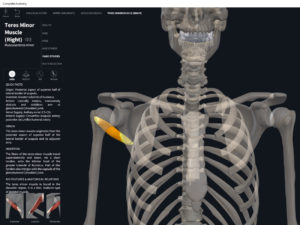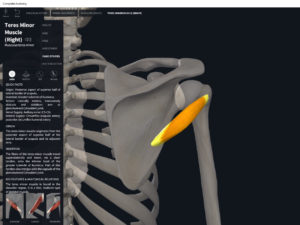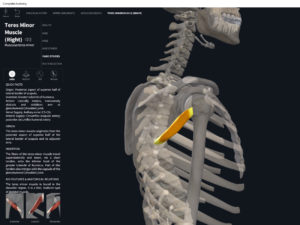Anatomy & Physiology: Muscles—Teres Minor.
Structure.
- Origin: inferior lateral border of scapula.
- Insertion: greater tubercle of humerus.
Function.
- Concentric action: shoulder external/lateral rotation, horizontal extension, and adduction.
- Reverse mover action: lateral tilt of scapula. Upward rotation of scapula.
- Eccentric action: controls/restrains/slows shoulder internal rotation, abduction, and horizontal flexion, and scapular downward rotation.
- Isometric action: stabilization of the shoulder girdle.
- Innervation: axillary nerve.
- Arterial supply: circumflex scapular artery (branch of subscapular artery); posterior circumflex humeral artery (branch of axillary artery).
Clinical Significance.
More.
- https://www.anatomynext.com/teres-minor/
- https://www.youtube.com/watch?v=UlADwGId8UI
- https://www.youtube.com/watch?v=am5XZ1VnoLc
- https://www.youtube.com/watch?v=jcgySb6f0Vg
References
Biel, A. (2015). Trail guide to the body: A hands-on guide to locating muscles, bones and more.
Cedars-Sinai. (2018). Vertebrae of the spine. Retrieved from https://www.cedars-sinai.org/health-library/diseases-and-conditions/v/vertebrae-of-the-spine.html
Clark, M., Lucett, S., Sutton, B. G., & National Academy of Sports Medicine. (2014). NASM essentials of corrective exercise training. Burlington, MA: Jones & Bartlett Learning.
Jenkins, G., & Tortora, G. J. (2012). Anatomy and Physiology: From Science to Life, 3rd Edition International Stu. John Wiley & Sons.
Muscolino, J. E. (2017). The muscular system manual: The skeletal muscles of the human body.



